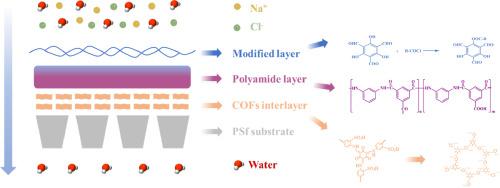Desalination ( IF 8.3 ) Pub Date : 2022-11-24 , DOI: 10.1016/j.desal.2022.116265 Huaigang Qi , Yu Peng , Xinghua Lv , Fangyi Xu , Baowei Su , Lihui Han

|
Reverse osmosis (RO) membrane technology is of great significance to solve the increasingly serious fresh water supply problem. Researchers have found that substrate and polyamide layer properties influence the separation performance of RO membranes greatly. In this work, an interlayer of ultra-thin and hydrophilic two-dimensional Covalent organic frameworks (COFs) nanomaterial was in-situ constructed on commercial polysulfone (PSf) substrate surface via interfacial reaction between 1,4-phenylenediamine-2-sulfonic acid (Pa-SO3H) and 1,3,5-triformylphloroglucinol (Tp), both with ultra-low concentration. This COFs interlayer successfully adjusted the interfacial polymerization (IP) process between m-phenylenediamine (MPD) and trimesoyl chloride (TMC), and thus helped to fabricate a kind of thin-film nanocomposites (TFN) RO membrane with excellent performance. Compared with the baseline thin-film composite (TFC) RO membrane without COFs interlayer, the water permeance of the TFN RO membrane was increased from 17.0 to 26.3 L m−2 h−1 MPa−1, accompanied with a NaCl rejection remaining about 99.3 %. The TFN RO membrane was further modified by ultra-low concentration Tp aqueous solution to reduce the surface defects and improve the separation performance. The formed TFN-Tp RO membrane has a further increased water permeance from 26.3 to 31.1 L m−2 h−1 MPa−1, and an increased NaCl rejection from 99.3 % to 99.5 % as compared with the TFN RO membrane.
中文翻译:

COFs层间调控与表面改性对高性能薄膜纳米复合反渗透膜的协同作用
反渗透(RO)膜技术对于解决日益严峻的淡水供应问题具有重要意义。研究人员发现,基材和聚酰胺层的特性对反渗透膜的分离性能影响很大。在这项工作中,通过 1,4-苯二胺-2-磺酸 (1,4-phenylenediamine-2-sulfonic acid) ( Pa-SO 3 H) 和 1,3,5-三甲酰间苯三酚 (Tp),均具有超低浓度。该 COF 夹层成功地调整了m之间的界面聚合 (IP) 过程-苯二胺(MPD)和均苯三甲酰氯(TMC),从而帮助制备了一种性能优异的薄膜纳米复合材料(TFN)反渗透膜。与没有 COFs 夹层的基线薄膜复合 (TFC) RO 膜相比,TFN RO 膜的透水率从 17.0 增加到 26.3 L m −2 h −1 MPa −1,同时 NaCl 阻隔率保持在约 99.3 %。TFN反渗透膜通过超低浓度Tp水溶液进一步改性,减少表面缺陷,提高分离性能。形成的 TFN-Tp RO 膜的透水率从 26.3 进一步提高到 31.1 L m -2 h -1 MPa -1,并且与 TFN 反渗透膜相比,NaCl 截留率从 99.3% 提高到 99.5%。





















































 京公网安备 11010802027423号
京公网安备 11010802027423号